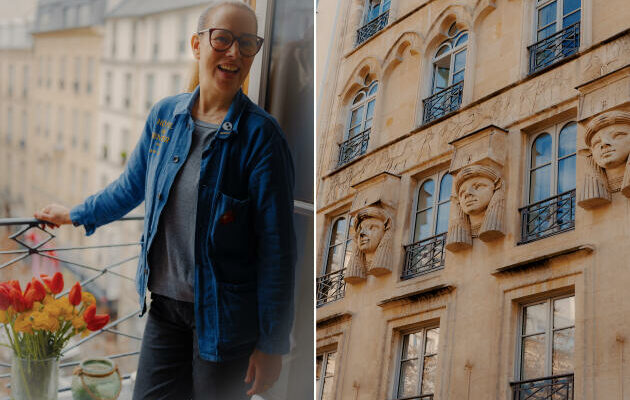Rue d’Aboukir, emblematic artery of the 2e district of Paris, neighboring rue Montorgueil, carries with it distant stories. The most obvious, the one from which it inherited the name at the beginning of the 19th centurye century, relates to the Egyptian campaign of Napoleon Bonaparte. In 1799, the French won a battle over the Ottomans in Aboukir, not far from Alexandria. To celebrate this military event, the old rue Bourbon-Villeneuve was renamed. All around are the streets of Alexandria, the Nile, Damietta and the Place du Caire, which has become inseparable from the Rue d’Aboukir by swallowing up its sidewalk. The entire district then took the nickname “Little Egypt”. It was the birth of Parisian Egyptomania and its powerful imagination tinged with fantasy exoticism and imperial myth.
Through the golden foliage of the beautiful soap makers of Place du Caire, the eye falls on the side facade of the Hôtel du Sentier, from which emerge three sculpted faces of the Egyptian goddess Hathor, divinity of love with cow’s ears . Dating from 1828, these sculptures and their almost kitsch hieroglyphic friezes illustrate an architecture called “return from Egypt”. The tortuous Cairo passage, the longest and oldest covered crossing in Paris, built in 1798, must have evoked an Oriental bazaar.
Loving the neighborhood, Samuel Castro, an emergency doctor, brought his entire family to live on rue d’Aboukir. “My grandfather Albert was a tailor and had a shop in the area. I was happy to come back here”, he says. With his wife, Charlotte, it was he who opened the Hôtel du Sentier and its restaurant in 2021, whose terrace enlivens Place du Caire in summer.
In the second half of the 19th centurye century, the Sentier district became heterogeneous, popular and dense: small traders, artisans, journalists, prostitutes and immigrants from all over the world rub shoulders there. After the war, the population of Aboukir was no longer united within a single commercial history, that of textile manufacturing which gave rhythm to street life. On the ground floor, ready-to-wear wholesaler boutiques abound and manufacturing workshops buzz on the upper floors.
“On Monday, the whole neighborhood was in turmoil because it was the day when the provincial wholesalers came to do their shopping. There were traffic jams, horns were honking in all directions, people were passing by with racks full of clothes”remembers Lou Borestein, whose parents, Ashkenazi Jews, owned an upstairs clothing workshop in 1973. His mother designed elegant evening dresses and draped her fabrics on Stockman busts.
You have 68.23% of this article left to read. The rest is reserved for subscribers.
